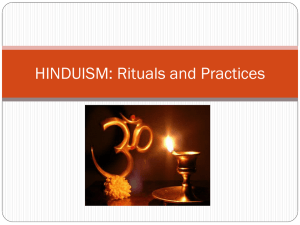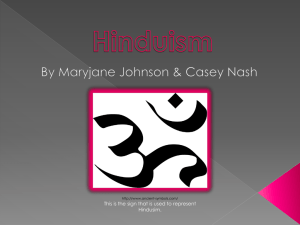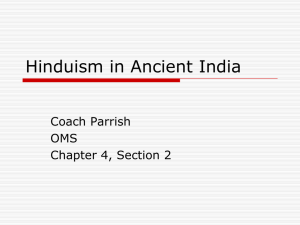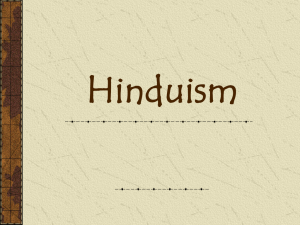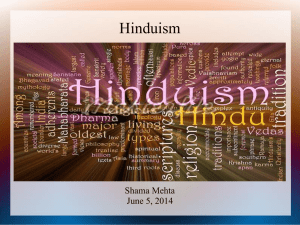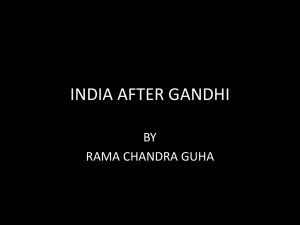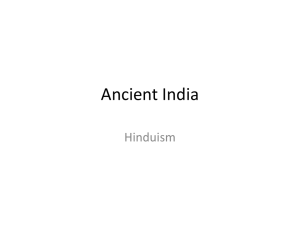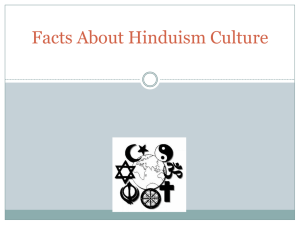are-hindus-polytheists-2 - Jon P. Dorschner India in the Clear Light
advertisement
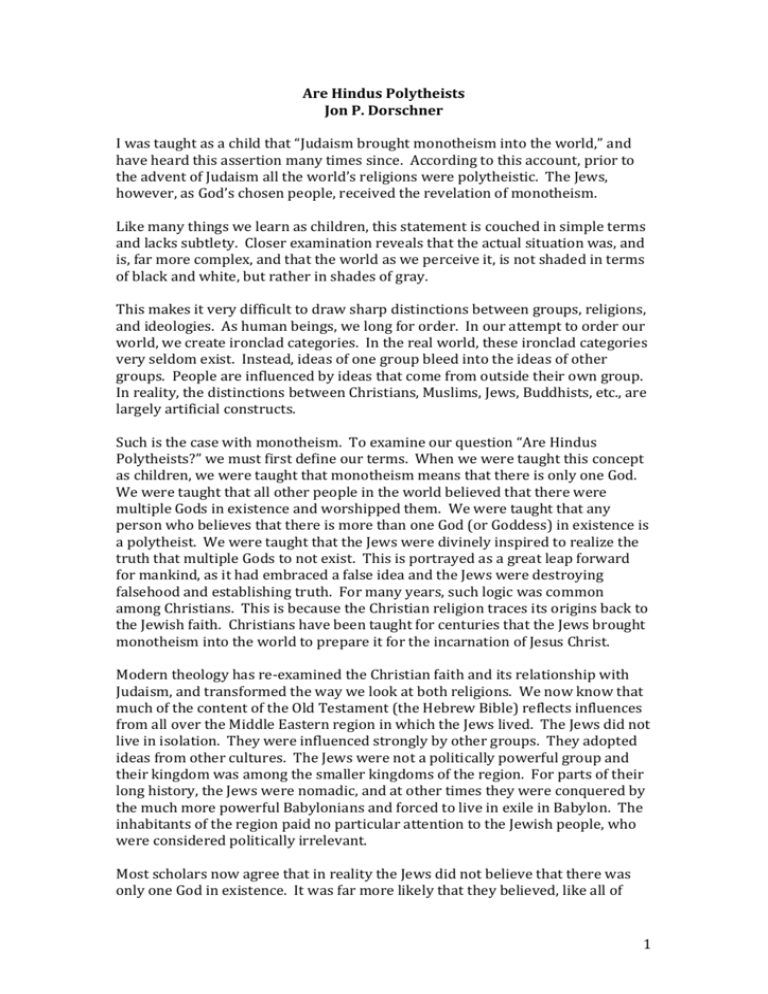
Are Hindus Polytheists Jon P. Dorschner I was taught as a child that “Judaism brought monotheism into the world,” and have heard this assertion many times since. According to this account, prior to the advent of Judaism all the world’s religions were polytheistic. The Jews, however, as God’s chosen people, received the revelation of monotheism. Like many things we learn as children, this statement is couched in simple terms and lacks subtlety. Closer examination reveals that the actual situation was, and is, far more complex, and that the world as we perceive it, is not shaded in terms of black and white, but rather in shades of gray. This makes it very difficult to draw sharp distinctions between groups, religions, and ideologies. As human beings, we long for order. In our attempt to order our world, we create ironclad categories. In the real world, these ironclad categories very seldom exist. Instead, ideas of one group bleed into the ideas of other groups. People are influenced by ideas that come from outside their own group. In reality, the distinctions between Christians, Muslims, Jews, Buddhists, etc., are largely artificial constructs. Such is the case with monotheism. To examine our question “Are Hindus Polytheists?” we must first define our terms. When we were taught this concept as children, we were taught that monotheism means that there is only one God. We were taught that all other people in the world believed that there were multiple Gods in existence and worshipped them. We were taught that any person who believes that there is more than one God (or Goddess) in existence is a polytheist. We were taught that the Jews were divinely inspired to realize the truth that multiple Gods to not exist. This is portrayed as a great leap forward for mankind, as it had embraced a false idea and the Jews were destroying falsehood and establishing truth. For many years, such logic was common among Christians. This is because the Christian religion traces its origins back to the Jewish faith. Christians have been taught for centuries that the Jews brought monotheism into the world to prepare it for the incarnation of Jesus Christ. Modern theology has re-examined the Christian faith and its relationship with Judaism, and transformed the way we look at both religions. We now know that much of the content of the Old Testament (the Hebrew Bible) reflects influences from all over the Middle Eastern region in which the Jews lived. The Jews did not live in isolation. They were influenced strongly by other groups. They adopted ideas from other cultures. The Jews were not a politically powerful group and their kingdom was among the smaller kingdoms of the region. For parts of their long history, the Jews were nomadic, and at other times they were conquered by the much more powerful Babylonians and forced to live in exile in Babylon. The inhabitants of the region paid no particular attention to the Jewish people, who were considered politically irrelevant. Most scholars now agree that in reality the Jews did not believe that there was only one God in existence. It was far more likely that they believed, like all of 1 their neighbors, that multiple divine beings existed. This is reflected in the wording of the Ten Commandments. In the book of Exodus, God delivers the Ten Commandments to Moses. The very first Commandment is usually cited as the statement regarding monotheism. It is contained in Chapter 20, verses two and three, and reads, “I, the Lord, am your God, who brought you out of the land of Egypt, that place of slavery. You shall not have other gods, besides me.”1 This Commandment does not state that there is only one God, but that the God of the Jews is superior to all other Gods and that, as such, the Jews shall worship this God of the Jews exclusively, and not pay homage to other deities. This means that the Jews practiced not strict monotheism, but rather henotheism, which is defined as “the worship of one God, without denying the existence of other Gods.”2 Henotheism straddles both monotheism and polytheism, but stands within in that its practitioners acknowledge the existence of other Gods, but worship only one God exclusively. Henotheism is a metaphysical concept that states that there are multiple divine beings in existence, but since only one is deserving of worship, it is a monotheistic concept. The other divine beings may exist, but their existence is basically irrelevant, since they play no role in the life of the worshipper and are not worshipped. One could argue that Christians are themselves henotheists because they believe in the existence of other divine beings. Most Christians profess to believe in angels, for example, and believe them to be divine beings that intercede in the lives of human beings. Likewise, many Christians believe that the Virgin Mary and the Saints can also intercede on behalf of human beings. Most importantly, an essential tenet of the Christian faith is that God is a trinity, defined as three persons, Father, Son, and Holy Ghost. The followers of the Prophet Mohammad (Muslims) believe themselves to be the followers of the true faith, because they assert that Muslims are the true monotheists. The essential tenets of Islam as stated by the Prophet Mohammad are summarized within the six Kalima. Four of the six Kalima repeat the essential message that “There is no God but Allah.”3 Because of his insistence that there is only one God, the Prophet Mohammad has been characterized as a “radical monotheist.” He rejected the Christian trinity and the belief that Jesus Christ is an incarnation of God, as heresy, asserting that these beliefs are a type of polytheism. Orthodox Muslims also reject the concept of sainthood, stating that there is no such thing as holy persons who can perform miracles or intercede in the lives of human beings after their death. For Muslims, Jesus Christ is not an incarnation of God, but rather one of the many prophets that New American Bible, Catholic Book Publishing Company, New York, 1970, page 78 2 Merriam Webster Dictionary, online version 3 “The Six Kalimas,” at IslamAwareness.com 1 2 preceded Mohammed, who is the capstone of the prophets. Likewise, Muslims revere Mary as the mother of Jesus but not as a saint. After the Protestant reformation, many Protestant thinkers also wrestled with the implications of henotheism. While they did not question the triune nature of God, they rejected Catholic teachings on the role of the Virgin Mary and the Saints, stating that prayers for intercession should only be addressed to God and Jesus. We have thus confirmed that while the Jews of the Old Testament were monotheists, they were not the strict monotheists that we think of today. Likewise, the Jews may not have been the first religious group to understand and propagate monotheism. Perhaps the Jews were the first religious group in the Middle East to do so. In those ancient days, the Jews had no contact with other areas of the world. For them, the Middle Eastern region was the world. Modern scholars now acknowledge the possibility that henotheistic monotheism could have arisen independently of the Jews in India, and that this development could have predated the advent of monotheism in the Middle East. The Hindu religion is not a codified religion like the Semitic faiths (Judaism, Christianity, Islam). It does not rely on a specific holy book, or set of teachings. It has no catechism. It is not “organized” in the way the Catholic church is organized, for example. It has no pope and no Vatican and no institution to determine which religious beliefs are valid or invalid. It has no dogma, no Apostles Creed that sets forth the tenets of the faith and can easily be learned and repeated. Instead, Hinduism is a culture rather than a religion in the Western sense. It consists of the cultural practices and attitudes of the inhabitants of the South Asian subcontinent as they have developed over millennia. Most Hindus think of their faith as the “sanatan dharma,” (eternal religion), that has no beginning and no end. Hinduism may be the oldest of the world’s major faiths, and has seen considerable change over the course of time. Like other religions, it is influenced by the beliefs and practices of those from outside that it encounters. Thus the encounters with Islam over the course of many centuries, and the over two hundred years of British Imperialism (and the encounter with evangelical Christianity supported by the colonial power), has had a profound impact on Hinduism. Since Hinduism is not dogmatic, it is not exclusivist. It therefore tends to pick and choose between the various ideas to which it is exposed, and feels free to adopt and modify these ideas to the South Asian cultural context. It has no concept of the “saved” and the “damned” and no belief that one particular religion is the “truth” and that all other religions are false. Without the concept of a single truth as contained within one religion, Hinduism does not have a concept of evangelism. For most Hindus, their religious 3 practices are thoroughly integrated within a South Asian cultural context. There is no concept of compartmentalization of religion, of an essential difference between the secular world and the religious world. Religion is not confined to one day of the week, for example, or to one specific building, or an organized religious service. In India religion is all-pervasive. It is found on every street corner, within vehicles, in countless shrines, and holy places and objects. It is most commonly practiced at home, either alone or with members of the family. Most Hindus therefore assume that their religion is a matter of birth within the Hindu culture. They find the idea of “conversion” from another religion into Hinduism as somewhat ludicrous and assume other cultures have their own faiths. Hindu nationalism is a recent concept and stresses the idea that Muslims and Christians living in India should abandon these foreign, imported faiths and “convert” to Hinduism. This “conversion” is reserved only for Indians; however, for Hindu nationalists stress that all the inhabitants of the South Asian subcontinent were originally Hindus. For them, Indian Christians and Muslims, are not “converting” to Hinduism, but rather returning to their ancestral faith. If Hindus are asked to summarize their religious beliefs, they provide a wide variety of answers. Religious practice in India spans the entire gamut of religious belief from a pantheistic belief in nature spirits that inhabit specific trees, bodies of water and mountains, through all forms of theistic worship to an impersonal belief an all-encompassing divine spirit (monism). Many Hindus view the offshoots of Hinduism, such as Jainism, Buddhism, and Sikhism, as adjuncts to Hinduism rather than totally separate religions. Lacking the rigidity of more dogmatic faiths, Hindus tend to revere anything that they believe sacred and feel no imperative to worship only Hindu deities at Hindu temples or engage only in Hindu religious practices. Hindus are commonly found at Sikh temples and Sufi shrines, for example.4 The principal factors keeping Hindus separate from practitioners of other faiths are social rather than theological. The caste system with its emphasis on ritual pollution is based on marital endogamy. Hindus are expected to marry within their own caste. In its most orthodox form, the caste system discourages interaction between members of higher and lower castes, out of fear that the high caste Hindu will be “polluted” by such contact. Food is viewed as a principal medium of pollution, with vegetarian food more ritually pure than meat. Since the religion and the culture are intertwined, many Hindus are reluctant to immerse themselves in foreign cultures. For example, it has been statistically A recent survey of American Hindus documented that 73% celebrate Christmas, 30% attend religious services of other faiths (the highest of any group polled), only 4% belief Hinduism to be the only true faith. The Pew Research Religion and Public Life Project. “Asian-Americans: A Mosaic of Faiths.” July 10, 2012 4 4 verified that Hindus, even long term residents of the United States, are the group least likely to marry members of other religious faiths.5 These factors make it difficult to generalize regarding Hindu religious beliefs. It is an often-repeated cliché in the United States that “Hindus worship thousands of Gods,” and that “Hindus worship the cow.” These prejudicial generalizations are based on a cursory examination of Hindu texts.6 Hinduism has no specific book that is universally acknowledged as the Hindu scripture. Instead, Hinduism has the world’s largest corpus of religious literature spanning priestly texts on religious ritual, epics that are vast in scope, and many philosophical works. Over the course of millennia, numerous Gods and Goddesses have been mentioned in these works. This does not mean that Hindus worship them today. In addition, there is a divide within Hinduism between folk beliefs and Sanskritic or Vedic Hinduism. For thousands of years the vast majority of Hindus lived in rural villages, often isolated from the rest of the world. These rural people often practiced a form of folk religion based on the worship of local Gods and Goddesses, which in many cases are not mentioned in Hindu texts and epics. These are what anthropologists call the “Godlings” of India, who serve specific local purposes for specific worshippers. I would argue that the vast majority of Hindus the world over worship some form of personal God within an overall henotheistic concept.7 The most popular religious work in India is the Bhagavad Gita, which is a segment from the enormous epic, the Mahabharata. The Bhagavad Gita plainly states that while many Gods exist and are deserving of worship, there is ultimately a supreme Lord, who rules over all existence. Text 12 of the Bhagavad Gita states that, “The demigods being pleased by sacrifices, will also please you, and thus, by cooperation between men and demigods, prosperity will reign for all.”8 The Pew Research survey confirmed that of all Asian Americans, Hindus are the most likely to retain their faith, “fully 81% of Asian Americans who were raised Hindu remain Hindu today.” Likewise, Hindu Americans are the least likely to marry outside their faith, “Nine-in-ten married Hindus (94%) have a spouse who is also Hindu.” This is a stark contrast with the American average. One quarter of all Americans are married to a person of a different religious faith. In addition, 78% of American Hindus maintain a religious shrine within their home, which is the principal focus of their worship. 6 Many of these statements are repeated by evangelical Protestants and find their origin in texts written by evangelical writers. These texts display an anti-Hindu bias because the authors have a vested interest in “saving the souls,” of Hindus by converting them to Christianity. 7 91% of American Hindus said they believed in a personal God. “Asian Americans – A Mosaic of Faiths 8 Bhagavad-Gita as it is, A.C. Bhaktivedanta Swami Prabhupada, Bhaktivedanta Book Trust, Los Angeles, 1998, page 174 5 5 Srila Prabhupada clarifies in his commentary on this verse that: “The demigods are empowered administrators of material affairs. The supply of air, light, water and all other benedictions for maintain the body and soul of every living entity is entrusted to the demigods….Their pleasures and displeasures are dependent on the performance of yajnas (sacrifices) by the human being. Some of the yajnas are meant to satisfy particular demigods; but even in so doing, Lord Vishnu is worshiped in all yajnas as the chief beneficiary.9” This reading of the Bhagavad Gita and its commentary makes it clear that a variation of henotheism is common within Hinduism and widely practiced. While practicing Hindus may not be able to articulate their religious faith in theological terms, I would argue that for the vast majority of Hindus would subscribe to a variant of this henotheistic concept. I would further argue that while some Hindus may perform worship (puja) to various divinities and divine personalities, they believe (as stated by Srila Prabhupada), that one deity is supreme with others subservient to that supreme deity. This is commonly expressed in terms of the “Prem Avatar.” Prem is the term defining “love.” “Avatar” means an incarnation of God. In this case, the Prem Avatar is the form of the Lord that the worshipper is most attracted to. For this worshipper, this is the Supreme Lord. All the other divinities are subservient. This differs little from the concept articulated in the book of Exodus, that one should worship the Supreme God and put none of the other Gods on the same platform. We substantiated that the Jews in the book of Exodus were monotheists. We must therefore extend the definition to the religious beliefs of most Hindus. This concept is made crystal clear in the Bhagavad Gita. Arjuna asks Krishna to display his universal form (Vishva Rupa). The Bhagavad Gita states that: “All the hosts of demigods are surrendering before You and entering into You. Some of them, very much afraid, are offering prayers with folded hands. Hosts of great sages and perfected beings, crying “All peace!” are praying to You by singing the Vedic hymns.10” The Bhagavad Gita takes the henotheistic concept one step further by depicting the Lord in His universal form as incorporating all the deities within the Hindu pantheon in a single being. In Text 23 Arjuna states upon seeing the universal form, 9 I.B.I.D., page 175 Bhagavad Gita as it is, text 22, page 570 10 6 O mighty-armed one, all the planets with their demigods are disturbed at seeing Your great form, with its many faces, eyes, arms, thighs, legs, and bellies and Your many terrible teeth; and as they are disturbed, so am I.11 This portion of the Bhagavad Gita is very profound, because it takes the concept of God into an entirely different dimension. Arjuna, like many other Hindus, perceives a henotheistic world order, with various divinities serving specific functions under the head of a Supreme Lord. However, the Bhagavad Gita reveals that this concept is only an intermediary step. The Lord tailors himself to the perceptions of the worshipper. If intellectually and spiritually the worshipper is incapable of understanding the vishwa rupa, the worshipper is free to continue to propagate specific Gods in hopes of winning specific divine favors. However, ultimately, as the worshipper progresses, he gains intimations of a more subtle reality. He learns that every diety in the pantheon is simply a part and parcel of the Supreme Lord. Hinduism then takes a leap from henotheism (a modified form of monotheism) into a pure monotheism in which other Gods are no longer necessary. This emphatic monotheistic statement in one of Hinduism’s most widely-revered scriptures, serves as a rejection of assertions that Hindus are polytheists. In 11 I.B.I.D., page 572 7 essence, Hindus are no less monotheists than any follower of Islam, Christianity, or Judaism. 8
